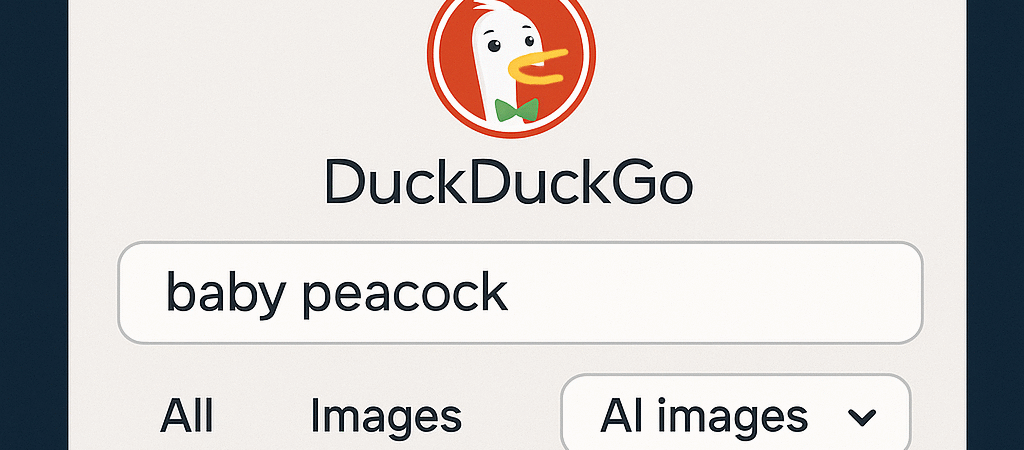1. Introduction: Taking Back Control in a Flood of AI Content
These days, the internet is flooded with AI-generated content—images, videos, even full articles. While some of it is helpful, a lot of it feels low-quality or fake. People are calling this flood of content “AI slop.” It’s getting harder to find real, authentic information online.
That’s why DuckDuckGo, the privacy-focused search engine, just introduced a new tool: a filter that lets you hide AI-generated images in your search results. It’s a direct response to user complaints and shows that DuckDuckGo is serious about putting control back in users’ hands.
Unlike Google and Bing, which are busy adding more AI features into everything, DuckDuckGo is taking a different path. They’re saying, “You choose how much AI you want.” Their guiding rule is simple: everything should be private, useful, and optional.
This article takes a closer look at how the filter works, why it matters, and how it stacks up against other search engines.
2. The Problem: Fake and Low-Quality AI Images Are Everywhere
Generative AI tools have made it super easy to create content. As a result, AI-made images are showing up more and more in search results. The problem? Many of these images look weird, inaccurate, or just feel fake.
One popular example is the search term “baby peacock.” For a long time, Google search results for this term were full of AI-generated images—many of them strange or unrealistic. People just wanted to see real baby peacocks, but instead, they got flooded with AI creations. DuckDuckGo used this example to show why their new filter is necessary.
This issue isn’t just annoying—it can cause real problems. Whether you’re a journalist, student, or just someone trying to find accurate info, seeing fake images can mess up your understanding of a topic. In serious fields like medicine or research, it can even be dangerous.
In short: people want content they can trust. AI results might be “relevant” according to the algorithm, but that doesn’t mean they’re real or useful. Search engines need to do more than just serve results—they need to help people find truthful, human-created content.
3. How DuckDuckGo’s AI Image Filter Works
DuckDuckGo built its new filter to reflect its long-standing mission: privacy and control for the user. They didn’t create their own AI detection system from scratch. Instead, they used open-source blocklists—lists of websites known for hosting AI-generated images. These include:
The “nuclear” list from uBlockOrigin
The Huge AI Blocklist from uBlacklist
This approach lets DuckDuckGo quickly block a wide range of AI-generated content without needing complex or expensive AI-detection tools. It’s a smart, community-powered solution that stays updated over time.
Here’s how you can use the filter:
From Image Search: After any image search, click the “AI Images” dropdown and select “Hide”.
From Search Settings: Go into your DuckDuckGo settings and enable the “Hide AI-Generated Images” option.
Visit noai.duckduckgo.com: This special version of DuckDuckGo automatically hides AI images and turns off other AI tools too.
This feature won’t block every single AI-generated image—no filter is perfect—but it does remove a large amount of unwanted content. Currently, it only works on the DuckDuckGo search engine, not the browser. That may change in future updates.
4. Why It Matters: Empowering Users and Fighting Fake Content
This isn’t just a small update—it’s a big step in giving people control over what they see online. It reflects a growing desire for a more authentic, human-focused internet.
For DuckDuckGo, fighting AI-generated “slop” is also part of their broader goal: protecting users’ digital experience. Just like they block trackers and scam sites, this filter helps users avoid misleading or fake content.
Other companies may be rushing to add more AI to everything, but DuckDuckGo is listening to users who are saying, “We want less.” That kind of choice matters.
And it’s not just about trust. It’s about user comfort. Many people feel overwhelmed or even creeped out by AI-generated stuff, especially when it sneaks into places they don’t expect. Having a simple toggle to block it feels refreshing.
5. How Google and Bing Compare
Shows AI Overviews at the top of search results by default.
Says it values content that shows expertise and trust, no matter who or what wrote it.
Has no direct way to block AI-generated images.
Some users try workarounds like adding “-AI” to search terms or using browser extensions.
Bing
Uses AI-powered answers similar to Google’s.
Lets users create AI images with Bing Image Creator.
Clearly marks AI-made images with watermarks.
Also has no built-in filter to hide AI-generated visuals from general search.
In short:
Google and Bing are betting on more AI by default. DuckDuckGo is betting on letting you decide. That difference in approach could become a big deal as people grow more cautious about what they see online.
Final Thoughts: DuckDuckGo Is Listening
In a world where AI is becoming harder to avoid, DuckDuckGo’s image filter is a rare tool that puts users back in control. It’s not just about blocking fake pictures—it’s about trust, choice, and transparency.
By making AI features optional instead of automatic, DuckDuckGo is standing out as a privacy-first, user-focused alternative to the big tech giants. For people who want a cleaner, more human online experience, that’s a pretty compelling reason to switch.

